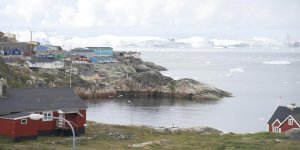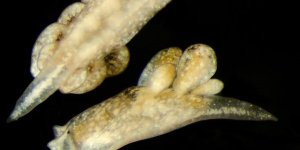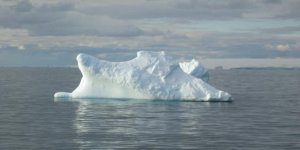Science News

Cyanide and carbon monoxide are both deadly poisons to humans, but compounds containing iron, cyanide, and carbon monoxide discovered in carbon-rich meteorites by a team of scientists at Boise State University and NASA may have helped power life on early Earth. »

New research shows that an iceless Greenland may be in the future. If worldwide greenhouse gas emissions remain on their current trajectory, Greenland may be ice-free by the year 3000. By the end of the century, the island could lose 4.5% of its ice, contributing up to 13 inches of sea level rise. »

Feet from the raw bars and seashell-colored condominiums of Florida's Cedar Key, NSF-supported researchers at the Florida Museum of Natural History and California State University discovered a new species of sea slug that is a rare outlier in a group famous for being ultra-vegetarians. »

Plants need nutrients to grow. So scientists were surprised to learn that giant kelp maintains its impressive growth rates year-round, even in summer and early fall when ocean currents along the California coast stop delivering nutrients. »

Vast subtropical gyres -- large systems of rotating currents in the middle of the oceans -- cover 40% of the Earth. The gyres have long been considered biological deserts, with waters that contain very few nutrients to sustain life. »

Higher levels of a customary gut bacteria enhanced by breastfeeding in early infancy were found to be coupled with an improved response to vaccines in infants through two years of age. »

A new research suggests that time of day exercise is completed may impact its physical effects. »

Since scientists first determined that atmospheric carbon dioxide was lower during ice ages than during warm phases, they have looked at why, theorizing that it may be a function of ocean circulation, sea ice, iron-laden dust or temperature. »

Winter ice on the surface of Antarctica's Weddell Sea sometimes has an enormous hole called a polynya. A polynya that appeared in 2016 and 2017 offered a unique opportunity for oceanographers to monitor this expanse of ice-free water. »

Space, Universe.
In this video, discover how NASA has explored the space beyond Earth and our solar system. »

Device measures hormones in sweat, blood, urine or saliva to determine stress. »

A new study by researchers at the Woods Hole Oceanographic Institution and Harvard University may help settle a long-standing question: how do small amounts of organic carbon become locked away in rock and sediment, preventing it from decomposing? »

Planetary scientists at Caltech and NASA's Jet Propulsion Laboratory in Pasadena, California, have discovered that the yellow color visible on portions of the surface of Europa is actually sodium chloride. »

Science, Engineering.
Carbon dioxide converted into cost-competitive fuels and chemicals? A team of engineers have developed technology to do just that, in the size of a small suitcase. »

A team of UK scientists have identified the mechanism behind hardening of the arteries, and shown in animal studies that a generic medication normally used to treat acne could be an effective treatment for the condition. »

Researchers have shown how millions of years of climate change affected the range and habitat of modern birds, suggesting that many groups of tropical birds may be relatively recent arrivals in their equatorial homes. »

Results of study involving primates suggest that speech and music may have shaped the human brain’s hearing circuits. »
Two children’s milk teeth buried deep in a remote archaeological site in north eastern Siberia have revealed a previously unknown group of people lived there during the last Ice Age. »

Results of a new study led by researchers at the Woods Hole Oceanographic Institution and Swansea University Medical School increase our knowledge of viruses -- in the sea and on land -- and their potential to cause life-threatening illnesses. »

More than 90 percent of flowering plant species combine male and female characteristics in one plant. In the less than 10 percent where female and male flowers exist on separate plants, they typically remain female or male throughout their lifetimes. But it isn’t always that simple. »

Space, Earth, Moon, Animation.
On December 24, 1968, Apollo 8 astronauts Frank Borman, Jim Lovell, and Bill Anders became the first humans to witness the Earth rising above the moon's barren surface. »

Space, Science, Sun, Astronomy, Animation.
Every 1.5 millionths of a second, the sun releases more energy than all humans consume in an entire year. Without the sun there would be no light, no warmth, and no life. »

A fungus genetically engineered to produce spider toxin can crush populations of malaria-spreading mosquitoes, according to a study hailed as a breakthrough by international scientists battling to combat the disease. »

Space, Animation, Earth.
Scientist Jay Herman narrates this video showing one year in the life of Earth seen through the lens of NASA's EPIC camera. »

Science, Research.
Chemists at the University of Iowa investigate how to remove radioactive substances from water. »

Science, Research.
Researchers develop modular robots that can autonomously adapt to changing environments. »

Space, Science, Conference.
Astronaut Scott Kelly spent one-year aboard the International Space Station. »

The mystery of why Earth has so much water, allowing our "blue marble" to support an astounding array of life, is clearer with new research into comets. »

Interplay between mitochondria and the nucleus may have implications for changing cell’s ‘batteries’
Mitochondria, the ‘batteries’ that produce our energy, interact with the cell’s nucleus in subtle ways previously unseen in humans. »

Earth's mantle is usually shown in a yellow-to-orange gradient, a nebulously defined layer between the crust and the core. »

The harmful effects of microplastics on the marine environment are widely documented. But now a new study says the tiny plastic debris acts as a carrier for pollutants resistant to environmental degradation, adding to the risks to animal and human health. »

Accelerated tree growth caused by a warming climate does not necessarily translate into enhanced carbon storage, an international study suggests. »

A tiny obstacle course for bacteria has shown researchers how E. coli changes its behavior to rapidly clear obstructions to food. »

Repetition can be useful if you're trying to memorize a poem, master a guitar riff, or just cultivate good habits. When this kind of behavior becomes compulsive, however, it can get in the way of normal life -- an impediment sometimes observed in illnesses such as Tourette's syndrome and autism spectrum disorders. »

Wearable electronic components incorporated directly into fabrics have been developed by researchers at the University of Cambridge. The devices could be used for flexible circuits, healthcare monitoring, energy conversion, and other applications. »

Geoscientists have discovered the first direct evidence that material from deep within Earth's mantle transition zone - a layer rich in water, crystals and melted rock - can percolate to the surface to form volcanoes. »

Researchers at the University of Cambridge have uncovered a specialised population of skin cells that coordinate tail regeneration in frogs. »

Scientists at the Scripps Institution of Oceanography at the University of California, San Diego, have found that low oxygen levels in seawater could blind some marine invertebrates. »

Scientists from the University of Granada have discovered that, although there were some variations in the eating habits of Megalithic communities over time, there were no significant social differences in the food types or the proportion of proteins consumed. »

An exquisite, fascinating fossil find in northern China has provided new evidence that some Jurassic dinosaurs developed membranous wings like those seen in modern day bats. »

Researchers at the University of Arizona and other institutions have discovered a new twist on the idea that evolution is driven by species interactions in a community. »

An international study has found that white people have difficulty distinguishing emotions on black people’s faces—a problem that does not appear to arise the other way around. »

Testing the blood for free fatty acids could help doctors verify if children fasted before undergoing tests for diabetes or other medical conditions. »

A team of scientists from the University of Granada (UGR) has broken new ground in Chagas disease research. This is a serious parasitic disease that affects more than 8 million people worldwide and for which there is currently no treatment. »

As much as 19 percent more carbon dioxide than previously believed is removed naturally and stored deep underground in seafloor trenches near island chains of volcanoes. »

Scientists from China's Tshinghua University and the Chinese Academy of Sciences reported bird flight may have evolved from wing-flapping by running dinosaurs. »

When the landmass that today is the Indian subcontinent slammed into Asia some 50 million years ago, the collision changed the configuration of the continents and altered global climate. »

Six million years ago, grass-eating mammals became more diverse in South America. Shifts in tropical atmospheric circulation known as Hadley circulation led to changes in climate and vegetation, especially grasses, which expanded the mammals' range. »

For most living things, arsenic is a deadly poison, but new research shows that microorganisms are breathing arsenic in a large area of the Pacific Ocean. »
